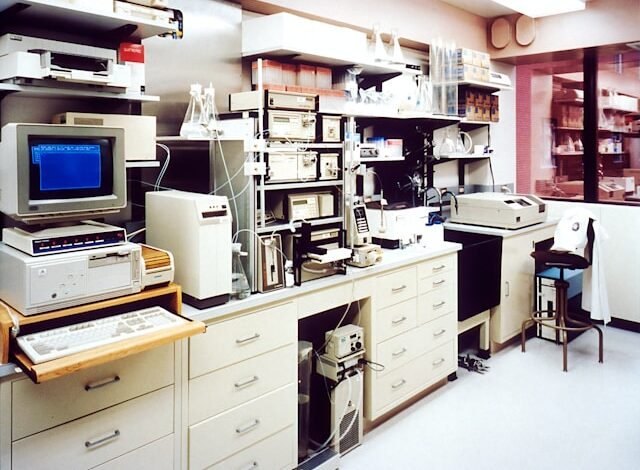How a Fume Hood can improve the Lab Working Conditions?

In any laboratory setting, ensuring the safety and well-being of researchers and technicians is of paramount importance. One of the most crucial elements in maintaining a safe laboratory environment is the effective management of hazardous substances. A laboratory fume hood is a fundamental piece of equipment that significantly enhances the safety and working conditions in a lab. This blog will delve into the various ways a fume hood can improve lab working conditions, the role of lab furniture in optimizing these benefits, and the importance of laboratory planning and design.
The Role of a Laboratory Fume Hood
A laboratory fume hood is a ventilated enclosure that provides a safe space for handling hazardous chemicals and materials. It works by drawing air from the laboratory into the hood and expelling it outside, thereby preventing the escape of harmful vapors, gases, and particulates into the lab environment. Here are some key ways in which a fume hood can improve lab working conditions:
- Protection from Hazardous Substances: One of the primary functions of a laboratory fume hood is to protect lab personnel from inhaling toxic fumes. When chemicals are mixed, heated, or reacted, they can produce harmful vapors. A fume hood captures these vapors at the source, minimizing the risk of exposure and protecting the health of researchers.
- Containment of Spills and Explosions: In the event of a chemical spill or an explosion, a fume hood can contain the incident, preventing the spread of hazardous materials. This containment feature is particularly crucial when working with highly reactive or volatile substances, as it ensures that any accidental release is confined within the hood, thereby safeguarding the rest of the lab.
- Improved Air Quality: By continuously removing contaminated air from the lab and replacing it with fresh air, a fume hood significantly improves the overall air quality. This reduction in airborne contaminants creates a safer and more comfortable working environment for all lab personnel.
- Compliance with Safety Regulations: Many safety regulations and standards require the use of fume hoods when handling certain hazardous materials. By incorporating fume hoods into the lab, institutions can ensure compliance with these regulations, thereby avoiding potential fines and ensuring the lab meets safety standards.
Integrating Fume Hoods with Lab Furniture
The effectiveness of a laboratory fume hood is significantly enhanced when it is integrated with appropriate lab furniture. Properly designed lab furniture not only supports the function of fume hoods but also contributes to an overall safer and more efficient laboratory environment. Here are some considerations for integrating fume hoods with lab furniture:
- Ergonomic Design: Lab furniture should be ergonomically designed to ensure that researchers can work comfortably and safely. Adjustable chairs, workbenches at appropriate heights, and strategically placed storage can reduce the risk of repetitive strain injuries and improve overall efficiency.
- Chemical Resistance: Furniture in a lab with fume hoods must be resistant to chemicals. Work surfaces and storage cabinets should be made from materials that can withstand exposure to corrosive substances, preventing damage and maintaining a clean, safe working environment.
- Proper Ventilation: Lab furniture should be designed to facilitate proper ventilation around fume hoods. This includes ensuring that airflows are not obstructed and that there is sufficient space for air to circulate freely. Proper ventilation is crucial for the effective operation of fume hoods and for maintaining good air quality in the lab.
- Storage Solutions: Integrating storage solutions within lab furniture can help keep hazardous materials organized and secure. Cabinets specifically designed for flammable or corrosive chemicals should be placed near fume hoods for easy access while ensuring safety.
The Importance of Laboratory Planning and Design
The benefits of a fume hood and well-designed lab furniture are maximized through careful laboratory planning and design. Proper planning ensures that the lab layout is optimized for safety, efficiency, and functionality. Here are some key aspects of laboratory planning and design that contribute to improved working conditions:
- Workflow Optimization: Effective lab design takes into account the workflow of lab activities. Fume hoods should be strategically placed to ensure they are easily accessible when needed. The placement of equipment, workbenches, and storage should facilitate smooth and logical movement through the lab, reducing the risk of accidents and increasing efficiency.
- Safety Zones: Creating designated safety zones within the lab can enhance safety. For example, areas with fume hoods can be designated as zones for handling hazardous substances, while other areas can be kept for less hazardous activities. This segregation helps to minimize the risk of cross-contamination and exposure.
- Flexibility and Adaptability: Laboratories should be designed with flexibility in mind to accommodate changing research needs and new technologies. Modular lab furniture and adjustable fume hoods can be reconfigured as required, ensuring that the lab remains functional and safe as research activities evolve.
- Emergency Preparedness: Incorporating features such as emergency showers, eyewash stations, and fire extinguishers into the lab design is crucial. These safety measures should be easily accessible and clearly marked, ensuring that lab personnel can respond quickly in the event of an emergency.
- Sustainable Design: Sustainability is becoming increasingly important in lab design. Energy-efficient fume hoods and eco-friendly lab furniture can reduce the environmental impact of the lab while also lowering operational costs. Sustainable design also promotes a healthier working environment by reducing exposure to harmful substances.
Conclusion
A laboratory fume hood is an essential component of any lab, providing critical protection from hazardous substances, improving air quality, and ensuring compliance with safety regulations. When integrated with well-designed lab furniture and supported by thoughtful laboratory planning and design, fume hoods contribute significantly to safer and more efficient working conditions. By prioritizing the safety and well-being of lab personnel through the use of fume hoods and smart design choices, institutions can create a productive and secure environment for scientific research and discovery.




